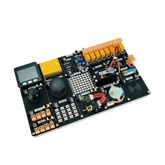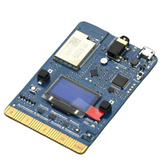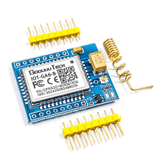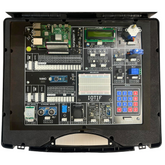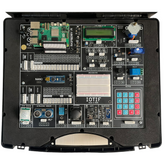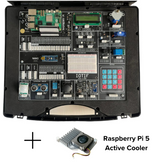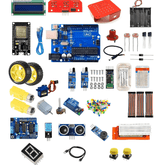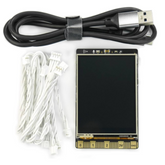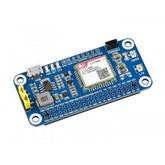What is IoT?
Summary
In this comprehensive blog, we delve into the fundamental concepts of Internet of Things (IoT) and its significance in modern society. Learn how to seamlessly control IoT devices, particularly with ESP32, a versatile microcontroller. Discover the enabling technologies behind IoT and explore its myriad benefits alongside potential drawbacks. From enhancing convenience to revolutionizing industries, IoT's impact is profound. Join us on this enlightening journey as we navigate the realm of IoT, empowering you to harness its power while considering its implications. Ready to revolutionize your connectivity? Let's dive in!
What is Internet of Things (IoT)
The Internet of Things (IoT) is a transformative network comprising interconnected devices embedded with sensors, software, and connectivity, enabling them to gather and exchange data.
These devices range from household appliances to industrial machinery and communicate with each other and centralized systems, such as cloud servers. IoT facilitates seamless interactions, automates processes, and enables real-time monitoring across various domains.
In homes, IoT devices like smart thermostats and security cameras enhance convenience and security by allowing remote control and monitoring via smartphones. In industries, IoT enables predictive maintenance, optimizing efficiency, and reducing downtime by continuously monitoring equipment performance and environmental conditions.
The Internet of Things revolutionizes how we see and interact with our surroundings. It enables higher efficiency, convenience, and innovation in many areas like healthcare, transportation, home automation, and industry.
As IoT progresses, its potential to transform industries and improve our lives becomes even more significant.

Explore the different Types of Sensors in IOT
Why is IoT Important?
The Internet of Things (IoT) changes how we live and work. People and Businesses rely on IoT to work better and smarter, improving efficiency, making data-driven decisions, saving money, and pleasing customers. Let's explore why IoT is crucial for businesses.
- Enhanced Efficiency: IoT enables automation of tasks, reducing the need for human intervention and streamlining processes.
- Cost Reduction: By automating processes and optimizing resource utilization, IoT helps businesses cut down on labor costs and waste.
- Real-Time Insights: IoT provides organizations with valuable, real-time data about their operations, facilitating informed decision-making.
- Improved Customer Service: Through IoT, companies can offer better service delivery by monitoring and responding to customer needs more efficiently.
- Supply Chain Optimization: IoT enables tracking and monitoring of goods throughout the supply chain, enhancing logistics operations and minimizing delays.
- Competitive Advantage: Businesses that use IoT gain a competitive edge by staying ahead of the curve in technology adoption and innovation and always coming up with new ideas.
- Smart Living: IoT enhances consumer lifestyles by offering convenient and efficient solutions for daily tasks, such as home automation and personalized experiences.
- Sustainability: By optimizing resource usage and reducing waste, IoT contributes to sustainable business practices and environmental conservation.
- Technological Advancement: IoT represents a significant advancement in technology, continually evolving to meet the changing needs of businesses and consumers alike.

How to Control IoT Devices:
Mobile Applications:
Managing IoT devices with phone apps is super easy. With manufacturers frequently offering dedicated apps, users can effortlessly manage their devices using smartphones or tablets.
These apps feature intuitive interfaces, allowing users to adjust settings, monitor real-time data, and execute commands from anywhere with an internet connection. Also, users can set up automated tasks and receive timely notifications for enhanced convenience and peace of mind
Voice assistants:
Controlling IoT devices through mobile applications can be more easier with voice assistants. Platforms like Alexa, Siri, and Google Assistant provide a natural and efficient means to manage smart home ecosystems.
By using these voice assistants with IoT device control, users can effortlessly execute commands and manage their devices using voice commands. Just ask them to do things like turn on lights or adjust the thermostat, and they'll do it for you. It's a simple and handy way to manage your smart home gadgets without having to touch your phone or tablet.
Web Interfaces:
Controlling IoT devices through web applications is convenient and versatile. You can use them on any device without downloading anything. It is great for managing lots of devices in industries like healthcare or manufacturing.
Web app users, typically system operators or administrators, can monitor thousands of devices in real time and analyze system health using professional tools.
While web apps are commonly used in professional settings, they also hold potential for consumer use. Users can control devices from their computer, turning it into an IoT controller, and easily share access through generated links, No need for them to download apps or sign up. It is an easy way to manage IoT gadgets in different situations.
Remote Control Protocol:
Using remote control protocols for IoT devices involves using specialized communication methods to connect devices with their controllers for efficient data exchange. Popular protocols like MQTT and CoAP are lightweight and reliable, making them perfect for IoT.
These protocols enable secure and smooth communication between devices and controllers, no matter where they are.
For example, MQTT uses a publish-subscribe model, where devices publish data to specific topics and controllers subscribe to those topics for updates. Similarly, CoAP offers a lightweight protocol for simple and efficient communication between IoT devices and controllers.
Bluetooth and BLE (Bluetooth Low Energy):
Controlling IoT devices through Bluetooth and BLE (Bluetooth Low Energy) means using these wireless technologies for short-distance connections between devices and controllers.
With Bluetooth, you can control devices directly from your smartphone or other Bluetooth-enabled gadgets. BLE is even better for devices with batteries since it uses less energy, making them last longer. By using Bluetooth and BLE, you can easily manage and interact with your IoT devices, making everything more convenient and user-friendly.
NFC:
Controlling IoT devices through NFC (Near Field Communication) means using this technology for quick and simple connections between devices that are close by. NFC is handy for tasks like pairing your phone with an IoT gadget or sharing data between devices.
It is a safe and straightforward way to control specific IoT devices, which is useful in places like factories or hospitals where things must be straightforward. With NFC, you can manage your IoT gadgets with just a tap or a wave, making everything easier.
Phone calls, SMS, and Email:
Controlling IoT gadgets through phone calls, texts, and emails gives you old-school ways to do it from afar. With phone calls, you dial a number to open things like gates if you are on the "allowed" list. Instead of using physical controllers, online services now make it easier to manage devices remotely.
Sending texts to certain numbers works similarly, handy if the internet is shaky or there is no Wi-Fi.
Email is less common but still an option—you can change device settings by emailing a special address. Even though these methods may seem old-fashioned, they are still useful when internet connections are not reliable.

What does the Internet of Things (IoT) Enable Technology?
Wireless Sensor Networks (WSNs):
Wireless Sensor Networks (WSNs) are networks of distributed devices with sensors that communicate wirelessly to monitor environmental and physical conditions. These sensors gather data like temperature, humidity, and air quality.
WSNs are used in various applications. For example, in weather monitoring, sensors collect atmospheric data for forecasting and climate research. Indoor air quality monitoring systems use WSNs to detect pollutants and maintain healthier indoor environments.
Cloud computing:
Cloud computing transforms the way we access and use computing resources. Instead of having to maintain physical hardware and infrastructure, users can tap into a vast pool of computing services over the Internet. These services include processing power (CPU), storage space, and networking capabilities.
One of the key features of cloud computing is its on-demand nature. This means that resources can be scaled up or down dynamically based on current needs. For example, if a website experiences a sudden spike in traffic, cloud resources can automatically expand to handle the increased load. Conversely, during periods of low demand, resources can be scaled back to save costs.
Cloud computing services are typically categorized into three main models: Infrastructure as a Service (IaaS), Platform as a Service (PaaS), and Software as a Service (SaaS).
Embedded systems:
Embedded systems are custom-built computers that do specific jobs. They are made up of hardware like microcontrollers or microprocessors, along with special software and operating systems.
These systems are all about doing one job well. They have strict limits on things like memory and speed, and they respond quickly to things happening around them.
In the world of IoT (Internet of Things), embedded systems are like the brains of smart devices. They collect data, process it, and make decisions right where the action is happening, which helps things run smoothly and quickly.
Big Data Analytics:
It is about dealing with large and diverse sets of data collected from various places. This data, called "big data," is tricky to handle with normal databases because it is so huge and comes in many different forms.
Big data has six main Vs characteristics: volume, variety, velocity, veracity, value, and variability. It encompasses massive amounts of data generated at high speeds from diverse sources, including structured, semi-structured, and unstructured data.
By leveraging advanced analytics techniques, organizations can extract valuable insights from big data, leading to informed decision-making, improved operational efficiency, and competitive advantages.
Communication Protocols:
Communication Protocols are like the rules that different devices in the IoT world follow to talk to each other. These rules include things like how data should be formatted, how it's sent and received, where it's supposed to go, and how errors are handled.
Following these rules means that IoT gadgets from different brands can understand each other and work together smoothly, even if they're connected through different kinds of networks.
Some common communication protocols in IoT are MQTT, CoAP, HTTP, and Zigbee. Each one is designed for different situations and needs.

What are the pros and cons of IoT?
Pros of IoT:
- IoT offers real-time operation and improved user experience, accessible through smartphones, enhancing daily life management.
- Automates energy consumption, infrastructure monitoring, and noise pollution control, optimizing urban living conditions.
- Facilitates Machine-to-Machine communication, supporting seamless connectivity and automation. This leads to substantial production cost savings and resource conservation, enhancing efficiency.
- Provides valuable customer insights, fostering new opportunities and revenue growth.
- Offers just-in-time training, improving employee efficiency and organizational productivity.
Cons of IoT:
- Managing multiple users or devices connected to IoT systems can lead to confusion and duplication of tasks and that complicates user experience.
- Variability in device manufacturers and standards can result in compatibility issues potentially limiting the interoperability of IoT devices and creating market monopolies.
- IoT devices pose risks to data privacy and security, with concerns over encryption effectiveness and potential leaks of personal information.
- The automation brought by IoT may lead to job displacement and unemployment. That is particularly a threat for low-skilled workers, as tasks become automated.
- Increased dependency on IoT for daily activities can lead to over-reliance on technology, potentially causing disruptions if systems fail or crash.
IoT applications:

- Agriculture: Monitoring micro-climate conditions and optimizing irrigation.
- Consumer Use: Enhancing daily life with wearables and smart homes.
- Healthcare: Remote patient monitoring and equipment maintenance.
- Insurance: Offering discounts for wearable fitness trackers.
- Manufacturing: Tracking products and optimizing production.
- Retail: Warehouse automation and personalized promotions.
- Transportation: Route optimization and traffic analysis.
- Utilities/Energy: Monitoring environmental conditions and improving energy efficiency.
- Wearables: Tracking health metrics and location.
- Traffic Monitoring: Using mobile phones for traffic data collection.
- Fleet Management: Geolocation and maintenance alerts for vehicles.
- Hospitality: Automating check-in processes and guest services.
- Smart Grid/Energy Saving: Monitoring electrical networks and optimizing energy usage.
- Water Supply: Remote monitoring of water consumption and leak detection.
- Maintenance Management: Real-time asset monitoring and predictive maintenance.
- Smart Home: Integrating home appliances and security systems.
- Smart Pollution Control: Forecasting and managing pollution levels.
- Smart Cities: Implementing IoT solutions for infrastructure optimization.
- Water and Waste Management: Monitoring water and waste quantities for optimization.
Conclusion
The Internet of Things (IoT) has become a game-changer in linking devices, and opening up new levels of efficiency, convenience, and innovation across various industries and everyday activities. Its key strength lies in its ability to gather, analyze, and act on data, leading to smarter decisions and better user experiences. While IoT brings many advantages like automation, improved communication, and better resource management, it also raises concerns about privacy, security, and potential job changes. Nevertheless, the widespread use of IoT keeps transforming our world, offering endless possibilities for connectivity and improvement. Moving ahead, it's vital to seize the opportunities while dealing with the challenges to fully benefit from IoT and build a more connected, efficient, and sustainable future.



